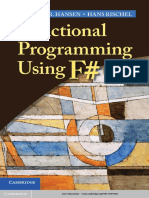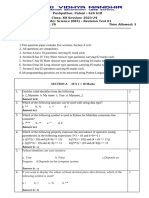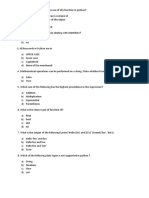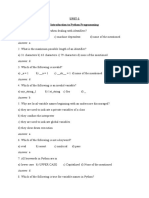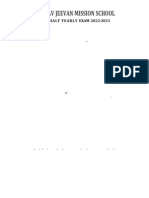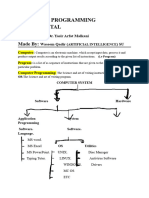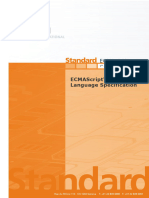0 ratings0% found this document useful (0 votes)
11 viewsbasics of python
The document contains a series of 20 multiple-choice questions related to the basics of Python programming. Topics covered include Python's creator, comments, identifiers, data types, functions, and operators. Each question provides options for answers, testing fundamental knowledge of Python syntax and concepts.
Uploaded by
angel788angelCopyright
© © All Rights Reserved
Available Formats
Download as PDF, TXT or read online on Scribd
0 ratings0% found this document useful (0 votes)
11 viewsbasics of python
The document contains a series of 20 multiple-choice questions related to the basics of Python programming. Topics covered include Python's creator, comments, identifiers, data types, functions, and operators. Each question provides options for answers, testing fundamental knowledge of Python syntax and concepts.
Uploaded by
angel788angelCopyright
© © All Rights Reserved
Available Formats
Download as PDF, TXT or read online on Scribd
You are on page 1/ 4
1 mark Questions BASICS OF PYTHON
1 Who developed Python Programming Language?
e) Wick Van Rossum
f) Rasmus Lerdorf
g) Guido Van Rossum
h) Niene Stom
2 In Python, which of the following characters is used to create single
line comment
e) //
f) #
g) !
h) /*
3 An identifier cannot start with a ________
e) Number
f) Character
g) Underscore
h) None of the above
4 ______________ has a specific meaning in python program
e) Constant
f) Variable
g) Keyword
h) Identifier
5 Write the output of the following python statement
print(10//3)
e) 3
f) 3.33
g) 1
h) 0
6 Which of the following is the valid Python file extension?
e) . python
f) . pl
g) . py
7 Numbers with fractions or decimal points are called ________
datatype.
e) Integer
f) String
g) Float
h) None of the above
8 _______is an ordered sequence of letters/characters. They are enclosed
in
single quotes (‘ ’ ) or double (“ ”).
e) String
f) Integer
g) Float
h) None of the above
9 ___________ are a sequence of values of any type, and are indexed by
integers.
They are immutable and enclosed in ().
e) String
f) Lists
g) Tuples
h) All of the above
10 _________ function is used to display given output in python.
e) printf()
f) print()
g) scan()
h) None of the above
11 _________ function is used to take input from the user in python.
e) input()
f) insert()
g) store()
h) None of the above
12 The data type of 14.5 is __________
e) int
f) float
g) string
h) list
13 ___________ operator gives the remainder in Python.
e) %
f) /
g) //
h) *
14 __________ operator is used to find the square of a number
e) ^
f) *
g) **
h) //
15 What does the following code print?
if 4 + 5 == 10:
print("TRUE")
else:
print("FALSE")
e) TRUE
f) FALSE
g) None of them
h) TRUE FALSE
16 What will be the datatype of following variable ?
A= “100”
e) int
f) float
g) string
h) list
17 Smallest element of python coding is called ______
e) Identifiers
f) Tokens
g) Keywords
h) Delimiters
18 Find the invalid variable among the following:
e) 1st_place
f) my_place
g) _first
h) Fun
19 T=[10,20,30,40] is a type of which datatype in python
e) int
f) string
g) list
h) tuple
20 The _________ mode of python
gives instant result of typed
statement
e) Interactive mode
f) Script mode
g) Combination of
interactive and script mode
h) All of these
You might also like
- Digital Keywords A Vocabulary of Information Society and Culture Peters All Chapter Instant Download100% (1)Digital Keywords A Vocabulary of Information Society and Culture Peters All Chapter Instant Download62 pages
- Programming in Python Mcqs With Answers (2022) CsdNo ratings yetProgramming in Python Mcqs With Answers (2022) Csd63 pages
- PEPS QB_Problem Solving Techniques & Python FundamentalsNo ratings yetPEPS QB_Problem Solving Techniques & Python Fundamentals4 pages
- Chapter - 1 - Python Revision Tour - 1 (One Mark, MCQ Questions)No ratings yetChapter - 1 - Python Revision Tour - 1 (One Mark, MCQ Questions)2 pages
- COMPUTER SCIENCE CLASS XI QUESTION PAPER HY EXAM 2024-25No ratings yetCOMPUTER SCIENCE CLASS XI QUESTION PAPER HY EXAM 2024-255 pages
- Rev 1 _ q With Ans _python Basics and Flow Control 17.08.24No ratings yetRev 1 _ q With Ans _python Basics and Flow Control 17.08.247 pages
- Kendriya Vidyalaya Sangathan, Lucknow RegionNo ratings yetKendriya Vidyalaya Sangathan, Lucknow Region9 pages
- Podar International School Chinchwad STD Xi - (I Unit Test) Subject: Computer Science Date: 8-9-2020 Marks: 40No ratings yetPodar International School Chinchwad STD Xi - (I Unit Test) Subject: Computer Science Date: 8-9-2020 Marks: 403 pages
- Q1 Single Line Comments in Python Begin With Symbol.: Most Important Multiple Choice QuestionsNo ratings yetQ1 Single Line Comments in Python Begin With Symbol.: Most Important Multiple Choice Questions17 pages
- UNIT-1 Introduction To Python ProgrammingNo ratings yetUNIT-1 Introduction To Python Programming10 pages
- REV 3 - Q WITH ANS__ Dict Function Exception 30.08.24 (1)No ratings yetREV 3 - Q WITH ANS__ Dict Function Exception 30.08.24 (1)8 pages
- Download Full Test Bank for Technology for Success and Shelly Cashman Series Microsoft® Office 365 & Office 2019, 1st Edition, Sandra Cable, Susan L. Sebok, Joy L. Starks, Misty E. Vermaat, Jennifer T. Campbell, Mark Ciampa, Barbara Clemens, Steven M. Freund, Mark Frydenberg, Ralph Hooper, Ellen Monk, Lisa Ruffolo PDF All Chapters100% (21)Download Full Test Bank for Technology for Success and Shelly Cashman Series Microsoft® Office 365 & Office 2019, 1st Edition, Sandra Cable, Susan L. Sebok, Joy L. Starks, Misty E. Vermaat, Jennifer T. Campbell, Mark Ciampa, Barbara Clemens, Steven M. Freund, Mark Frydenberg, Ralph Hooper, Ellen Monk, Lisa Ruffolo PDF All Chapters66 pages
- Chapter - 2 - Fundamentals of C++ Programming100% (2)Chapter - 2 - Fundamentals of C++ Programming16 pages
- Programming Notes With Type Declaration...No ratings yetProgramming Notes With Type Declaration...16 pages
- Object-Oriented Program Development Using Java: A Class-Centered ApproachNo ratings yetObject-Oriented Program Development Using Java: A Class-Centered Approach46 pages
- Elementary Programming: The Basics of JavaNo ratings yetElementary Programming: The Basics of Java116 pages
- CSE1021- Problem Solving and Programming -unit 2No ratings yetCSE1021- Problem Solving and Programming -unit 234 pages
- A Corpus of American and British English: A Case Study of SlangNo ratings yetA Corpus of American and British English: A Case Study of Slang18 pages
- CE100 - Chapter 3 - Operators (Expressions, Data Types and Variables)No ratings yetCE100 - Chapter 3 - Operators (Expressions, Data Types and Variables)24 pages
- Python Programming For Beginners The Definitive Guide, With Hands-On Exercises and Secret Coding Tips, To Master Python in Just One Week and Get Your Dream Job! by Ernstrom MaxwellNo ratings yetPython Programming For Beginners The Definitive Guide, With Hands-On Exercises and Secret Coding Tips, To Master Python in Just One Week and Get Your Dream Job! by Ernstrom Maxwell159 pages

